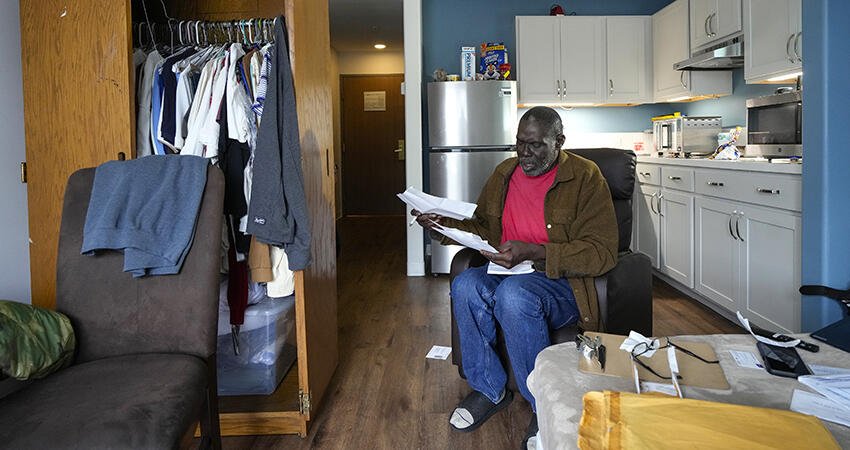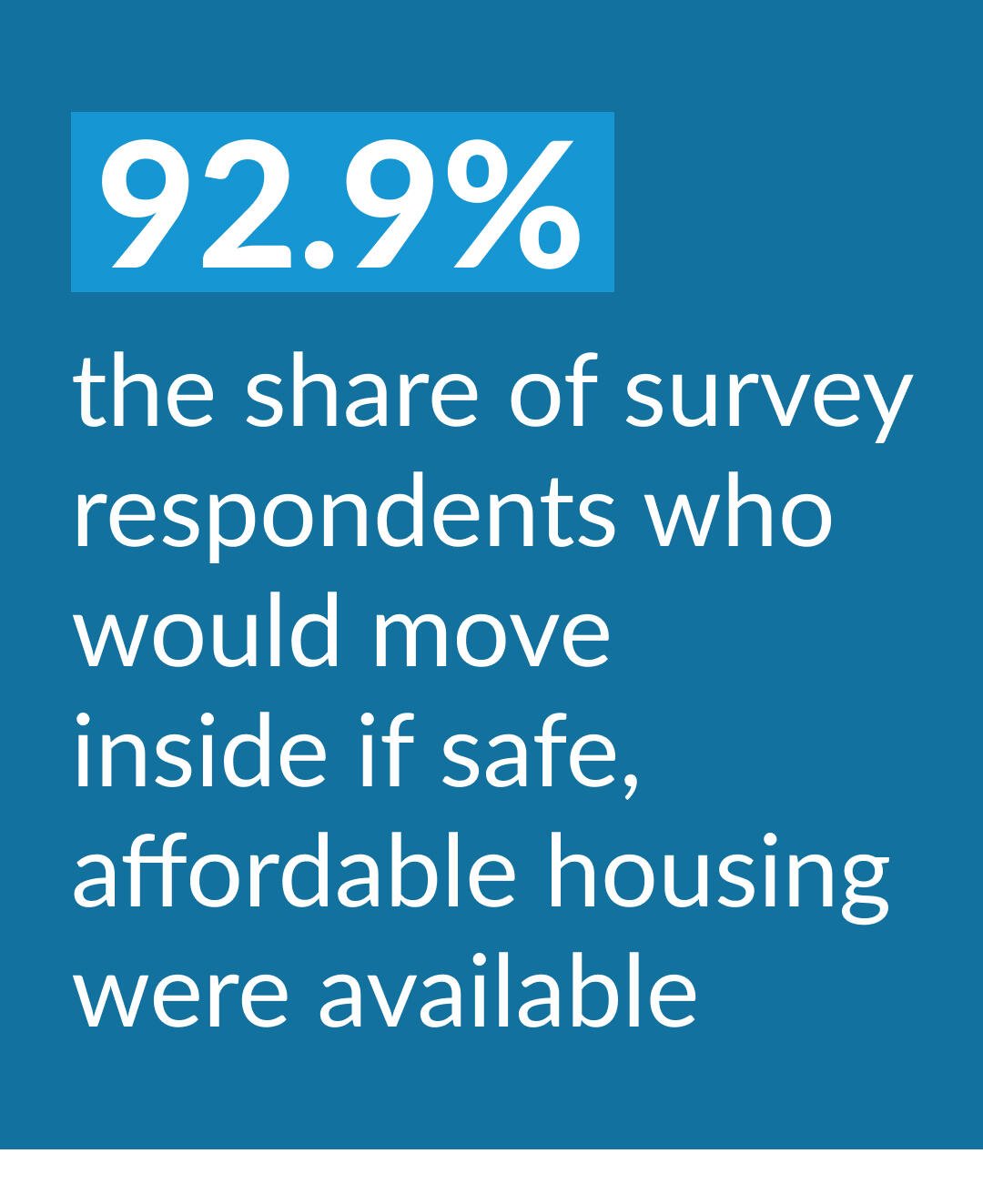
TOMBALL, TEXAS: Army veteran Reggie Austin sits in his apartment looking at some paperwork at the newly opened Tunnel to Towers Veterans Village on Tuesday, November 21, 2023, in Tomball. Tunnels of Towers opens phase 1 of the $10 million housing project that will place approximately 130 homeless veterans in rooms and provide services to help with PTSD, substance abuse, financial struggles and other challenges. (Brett Coomer/Houston Chronicle via Getty Images)
Housing First Is Still the Best Approach to Ending Homelessness
Homelessness hit a record high in 2023, amid a widespread shortage of affordable housing and the end of pandemic relief programs. That’s according to the US Department of Housing and Urban Development’s most recent Point-in-Time count, which found homelessness increased 12 percent (PDF) from the previous year.
As homelessness has trended upward in recent years, some have falsely blamed the rise on Housing First, an approach to addressing homelessness that involves quickly moving people into housing and then providing them voluntary, individually tailored services.
Misconceptions about Housing First ignore decades of evidence of its effectiveness. Randomized controlled trials in the US and Canada have demonstrated how permanent supportive housing programs—most of which use the Housing First approach—improve housing and quality-of-life outcomes for participants in the short and long term. Studies have also shown how these programs can reduce reliance on costly emergency services (PDF) and increase access to community-based care.
To end homelessness, policymakers at all levels should invest in evidence-backed solutions, such as permanent supportive housing.
Research done by the Urban Institute and other experts shows why Housing First interventions are still the best way to help people exit homelessness.
People experiencing homelessness want housing

Some politicians and influential figures have argued that people experiencing homelessness do not want housing, and are homeless by choice. Research from Urban and others clearly debunks this myth: people want safe, affordable housing. The problem is that they struggle to access it.
In 2016, the City of Seattle surveyed people experiencing homelessness in the city, and nearly all of the 892 respondents (92.9 percent) said they would move inside if safe, affordable housing were available (PDF).
Many of the respondents, who expressed a strong desire to move into stable housing, reported needing help to do so. When asked what supports would help them obtain permanent housing, two-thirds said rental assistance (68 percent) or a greater supply of affordable housing (65 percent).
A recent Urban report echoes the City of Seattle’s findings. In a survey of women experiencing homelessness in Los Angeles, we identified a lack of affordable housing (63 percent) and long waiting lists for housing assistance (56 percent) as the barriers women most frequently face in securing permanent housing.
These surveys provide a snapshot into the systemic failures underlying the increase in homelessness across the nation, such as the shortage of affordable housing and lack of livable wages. In 2023, a full-time minimum wage worker could not afford a modest apartment in any state, city, or county in the US. Furthermore, only one in five eligible households receives federal rental assistance.
Housing First helps people get housed and remain housed
Based in the Housing First approach, permanent supportive housing connects people experiencing multiple barriers to finding and retaining housing—such as chronic homelessness, disabilities, or substance use disorders—to affordable, long-term housing.
Randomized controlled trials—the gold standard for assessing intervention outcomes—in several US localities have shown that permanent supportive housing programs help people access housing and remain housed in the long term.
Recent research from Urban confirms these findings. Using a randomized controlled trial, Urban evaluated the effects of the Denver Supportive Housing Social Impact Bond Initiative, or Denver SIB, between 2016 and 2020. The program provided permanent housing subsidies and intensive services for people experiencing chronic homelessness. The study compared outcomes for program participants with those for people who received services as usual, which typically include emergency shelter.
Permanent supportive housing program participants were more likely to access housing and stay housed than people receiving services as usual. During the first year, people in the treatment group were housed for an average of 172 days, while those in the control group were housed for just 19 days. After three years, 80 percent of people in the treatment group had been housed for any amount of time, compared with just 18 percent of people in the control group.
By the end of the third year, people in the Denver SIB treatment group had spent an average of 654 days housed, whereas those in the control group had spent an average of only 94 days housed.
A four-year randomized controlled trial assessing a permanent supportive housing program in Santa Clara County, California, found similar outcomes. Out of the 199 people experiencing chronic homelessness assigned to the treatment group, 172 people, or 86 percent, were ever housed during the trial. By comparison, only 36 percent of the control group accessed housing.
In addition, the Santa Clara County trial found that supportive housing participants were housed for more than 84 percent of any one-year period during the four-year trial; by comparison, the control group was housed only 20 percent of any given year.
Housing First programs have been shown to improve people’s quality of life and facilitate use of health care services
A recent review of over two dozen studies found that Housing First programs led to greater improvements in participants’ quality of life than treatment as usual, such as emergency shelter. One five-year randomized controlled trial included in the review showed that among unhoused people with severe mental health challenges, those receiving support through a Housing First program experienced more rapid improvements in community functioning and quality of life.
Several studies found that Housing First programs reduce hospitalizations and emergency department use among participants. Our evaluation of the Denver SIB revealed that after two years, people referred to supportive housing had an average of six fewer emergency department visits than people receiving services as usual.
People referred to the Denver SIB program were also more likely to access prescription medications and office-based care services, and less likely to visit short-term or city-funded detoxification facilities. In other words, Housing First increased access to community-based care while reducing reliance on emergency services that are not equipped to provide follow-up care. The SIB provides compelling evidence that Housing First not only increases housing stability but facilitates use of health care services for people with many health care needs.
Housing First programs are cost effective
Providing both housing and supportive services, permanent supportive housing programs carry significant costs. But without these services, many people experiencing chronic homelessness are often stuck in a cycle involving costly emergency services (PDF), such as emergency rooms, detox facilities, and jails.
Our analysis of the SIB showed that as supportive housing helped increase participants’ housing stability and use of needed health care services, it also decreased their use of expensive emergency services such as jail stays, emergency room visits, and ambulance use, offsetting about half the program’s total per person annual cost. The per person annual cost of emergency public services for Denver SIB participants was on average $6,876 less than the control group.
These findings are consistent with a 2012 study that showed participants in a supportive housing program in New York City spent 40 percent less time in jail than people in the comparison group. Altogether, the annual crisis health care, jail, and shelter costs per person were more than $15,000 higher in the comparison group than for those in the supportive housing program.
When funded to the necessary scale, Housing First ends homelessness
Public debate about whether Housing First works overlooks a key point—it already has.
A 2014 study found that the rate of chronic homelessness in a community decreases as investment in permanent supportive housing increases. In addition, the faster a community increases the number of permanent supportive housing beds, the faster the rate of chronic homelessness drops.
Other studies have shown that the expansion of a permanent supportive housing program for veterans has not only reduced homelessness among veterans, but prevented a significant increase. In 2008, the US Department of Housing and Urban Development and US Department of Veterans Affairs’ Supportive Housing program began to significantly increase the number of supportive housing vouchers awarded to veterans, and it has offered roughly 10,000 additional vouchers each year since. For each voucher awarded between 2008 and 2017, the number of veterans experiencing homelessness decreased by one. Without the program, the study estimated an additional 90,000 veterans would have become homeless by 2017.
“Without a permanent supportive housing program for veterans, an additional 90,000 veterans would have become homeless by 2017.”
Veteran homelessness has dropped by 52 percent since 2009, when the US Department of Housing and Urban Development first began collecting veteran homelessness data. This decline corresponds to an increase in the number of supportive housing beds for veterans. In 2009, more than 73,000 veterans were experiencing homelessness; by 2023, that number had fallen to under 36,000.
Permanent supportive housing and other programs based in the Housing First approach can help us work toward ending homelessness. But to meet the housing and supportive-services needs of our communities, these programs need to be funded to scale.
With homelessness increasing nationwide, policymakers at the local, state, and federal levels should invest in evidence-backed solutions that help people exit homelessness and achieve greater stability. To prevent entries into homelessness, however, policymakers will need to address its underlying causes, such as by creating and funding a comprehensive affordable housing plan.
PROJECT CREDITS
This feature was funded by the Urban Institute's Housing Matters initiative. The views expressed are those of the authors and should not be attributed to the Urban Institute, its trustees, or its funders. Funders do not determine research findings or the insights and recommendations of our experts. More information on our funding principles is available here. Read our terms of service here. Learn more about Housing Matters’ funding principles here.
RESEARCH Samantha Batko, Sarah Gillespie, and Katie Fallon
DESIGN Christina Baird
DATA VISUALIZATION Rachel Marconi
EDITING Zach VeShancey
WRITING Dana Ferrante


